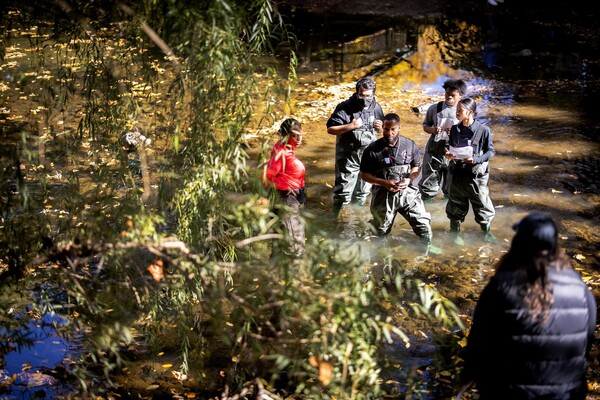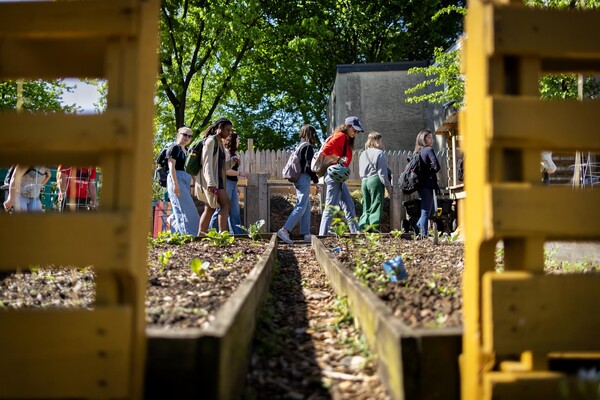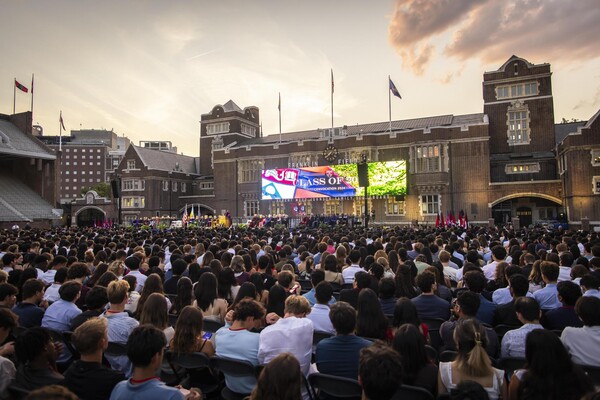Arctic trees last 45 million years
Above the Arctic Circle, on a Canadian island less than 700 miles south of the North Pole, a multidisciplinary team of scientists spent five weeks this summer exploring a bleak terrain that once was covered with a dense forest of trees that rose 120 feet.
Because the wood of that forest, and even many of the leaves, which grew about 45 million years ago, were preserved by nature over all this time Ñ not as coal, not as petrified wood, but as wood and leaves Ñ the scientists have a unique opportunity to figure out the ancient climate that fostered the forest, and perhaps to predict the effects of future climate changes.
Arthur Johnson uncovers an ancient tree trunk.
Photograph by David Vann
Graduate Group Chair Arthur H. Johnson, Ph.D., David Vann, Ph.D., and Ben LePage, Ph.D., all of the Department of Earth and Environmental Science, led a multidisciplinary team that included six Penn graduate students, an undergraduate, and scientists from Yale, the University of Maine and Georgia Tech to explore the forest primeval.
Getting there was travel primeval, a two-day trip with lost luggage and late connections that led them via jet, prop plane and helicopter to Houston to Calgary to Edmonton to Yellowknife to Victoria Island to Resolute Bay to Eureka (which bills itself as the Garden Spot of the ArcticÓ) to Axel Heiberg.
Vann recalled how the desolation of Resolute Bay stunned him. Axel Heiberg was worse.
The present-day climate, inhospitable to man and tree, is a windy, cold desert, with a reputation for summer weather rarely topping 40 damp degrees. But the season was kind to the expedition, and remained relatively mild through their stay, hovering around 50 for the most part, give or take 20 degrees. The scientists, funded by a Mellon Foundation grant, spent five weeks in perpetual daylight, sheltering in Quonset huts, with gas-powered generators running the computers and heating the laboratory.
Had the favorable weather not thawed the ground, the task of digging with pickaxes and shovels to unearth fallen trees and stumps might have been even more daunting.
The ancient mat of vegetation the scientists found was about 24 inches deep, said Vann. These areas of leaf litter are just as if you were walking on the forest floor, except the leaves are black now,Ó Vann said. You can pick up the leaves out of the ground.
The unique thing about this is it never got squashed.Ó
The islands wood is dawn redwood, a species that grows naturally in part of China and has since been planted in botanical gardens around the world, including the Universitys Morris Arboretum. The arctic forest provides a unique opportunity to compare the long-dead trees to modern counterparts.
While the scientists know for sure that the climate was warmer when the forest grew, they are trying to learn more. The multidisciplinary approach is allowing them to weigh a variety of clues. All of the evidence we collected suggests that this was a cool-temperate climate, probably a whole lot like Vancouver, maybe a little cooler,Ó Vann said.
The team approach, with specialists like Vann, who is a plant ecophysiologist, and specialists in mapping and sedimentary analysis, a wood anatomist and a geologist, for example, will allow for new breakthroughs in understanding. Were asking questions of a different scale, a scale that no ones ever been able to ask before, and are addressing relatively large issues,Ó Vann said.







